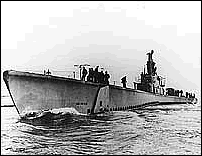|
Thailand - Since the discovery in May of the World War II wreck of the USS Lagarto, a 1,500 ton Balao class submarine, in the Gulf of Thailand, a new skirmish on and under the seas is surfacing.
On one side are the divers who discovered the wreck and who are eager to explore and film it. On the other side is the might of the  US military, which insists that the wreck should be left untouched out of respect for the 86 crewmen who went down with her. US military, which insists that the wreck should be left untouched out of respect for the 86 crewmen who went down with her.
For 60 years the Lagarto rested untouched on the seabed in 70 meters of water about 150 kilometers off the southeast coast of Thailand. Local dive operators on the tiny resort island of Koh Tao knew of the submarine's fate, but couldn't pinpoint her location until recently.
"We've always known that since the end of the war there's been a submarine missing around there," said British wreck diver Jamie MacLeod, who discovered the 110-meter submarine. "We went into all the war-time records, cross-referenced them with fishermen's marks and then searched with sonar and it came up trumps - we found a bump on the bottom, went down the line and there it was."
MacLeod said, "It looks to me like it's intact and it's sitting upright on the bottom in very clear water, so you can get a good idea of what it looks like. Everything is still on it - all the armaments, the brass navigation lights. It's beautiful."
The waters around Thailand are the final resting place for many warships that battled for domination of the oceans during World War II. Several well-known wrecks further north in the gulf are popular with recreational and technical divers.
At the time of discovery of the Lagarto, US officials unequivocally denied permission to local dive shop owners to dive the wreck, fearing that it would turn into a tourist attraction. A US Embassy spokesperson said the divers would never get permission to study the submarine because it belonged to the US Navy under international maritime law and was the final resting place for the people who went down with it.
Jeff Davis, spokesman for the US Pacific Fleet Submarine Force in Pearl Harbor, Hawaii, said the vessel discovered in May "is in the area where we suspected the Lagarto was". The Lagarto was one of 52 submarines that sank in the Pacific during World War II, he said. There are no plans to raise the vessel.
The term war grave was used to discourage further diving to the site. MacLeod has been sympathetic, recently saying, "It's nice because now the families are talking about closure," but he has maintained his position to seek official permission to dive the sub and has even gone to lengths to bring some of the Lagarto grandchildren to the site after contacting relatives of the crew through the US Submarines of WWII Veterans Association.
Lucy Foster, 79, a woman whose brother, Wardour Britain, died in May 1945 aboard the USS Lagarto, said, "Now we know that he isn't just missing, we know where he is." She is one of many relatives who can now get some closure for loved ones that have remained lost beneath the waves for six decades.
At the time of writing, divers are currently trying to obtain Pentagon permission to visit the wreck to conduct research and documentation.
Fateful encounter
USS Lagarto was one of many submarines produced during World War II by the Manitowoc Shipbuilding Co in Manitowoc, Wisconsin. The submarine was launched on May 28, 1944, in Lake Michigan. After test trials and training in Lake Michigan, Lagarto entered a floating dry-dock and was floated down the Mississippi River to New Orleans, where it departed for the Pacific.
Following a number of successful missions in Japanese waters the Lagarto (SS-371), under the command of Frank D Latta, departed Subic Bay in the Philippines for the South China Sea on April 12, 1945. She was directed to patrol in the Gulf of Siam, where sister-ship Baya (SS-318) joined her on May 2. That afternoon, Baya signaled that she was tracking a tanker traveling under heavy escort. The same night Baya tried to attack, but was driven off by enemy escorts equipped with radar.
The two submarines rendezvoused early next morning to discuss attack plans. The following night Baya made a midnight attack, but was again driven off by the unusually alert Japanese escorts. Early next morning, May 4, when Baya tried to contact her teammate, Lagarto made no reply. Since Japanese records state that during the night of May 3-4, mine-layer Hatsutaka attacked an American submarine in that location, it is presumed that Lagarto perished in battle with all hands. Its 86 crew members are still listed as missing in action.
Source: Asia Times Online |



